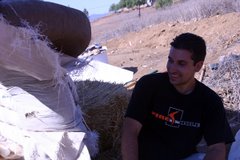It Takes a Village
Things have come a long way in the six months since our last post. The 2007-2008 team did an incredible job with projects implemented in Zimbabwe, Ethiopia, and the United States, among other areas. Economic development and empowerment with a methodology of identifying and building on strengths has become a core characteristic of how the La Sierra University Students in Free Enterprise Team operates.
The team completed the first test dome, as well as the construction of an emergency shelter, a great alternative to emergency tents as in many disaster-torn areas of the world, refugee camps and temporary shelter locations can end up needing to be used much longer than originally anticipated. The photo above is the most recent view of our on-campus village at La Sierra University. The three stacks of filled Cal-Earth bags you see in the photo are the start of a new ampitheatre for the village. It will be very useful as the team plans to hold special meetings, courses, workshops, open houses, and other events at the site throughout the year. Pictured in the photo are (left to right) Christian Tirado (2008 Team President/CEO), Roberto Anguiano (2007-2008 Team Recruitment), and Steven Salcido (2007-Current Build-a-Village Project Leader). The three have been working tirelessly in the hot California sun to complete more of the vision for this village on a university campus.
The 2008-2009 academic year is upon us. Look for some incredible new developments from the La Sierra University Students in Free Enterprise Team as it continues to increase its own potential to make a true, sustainable difference in the world around them.


